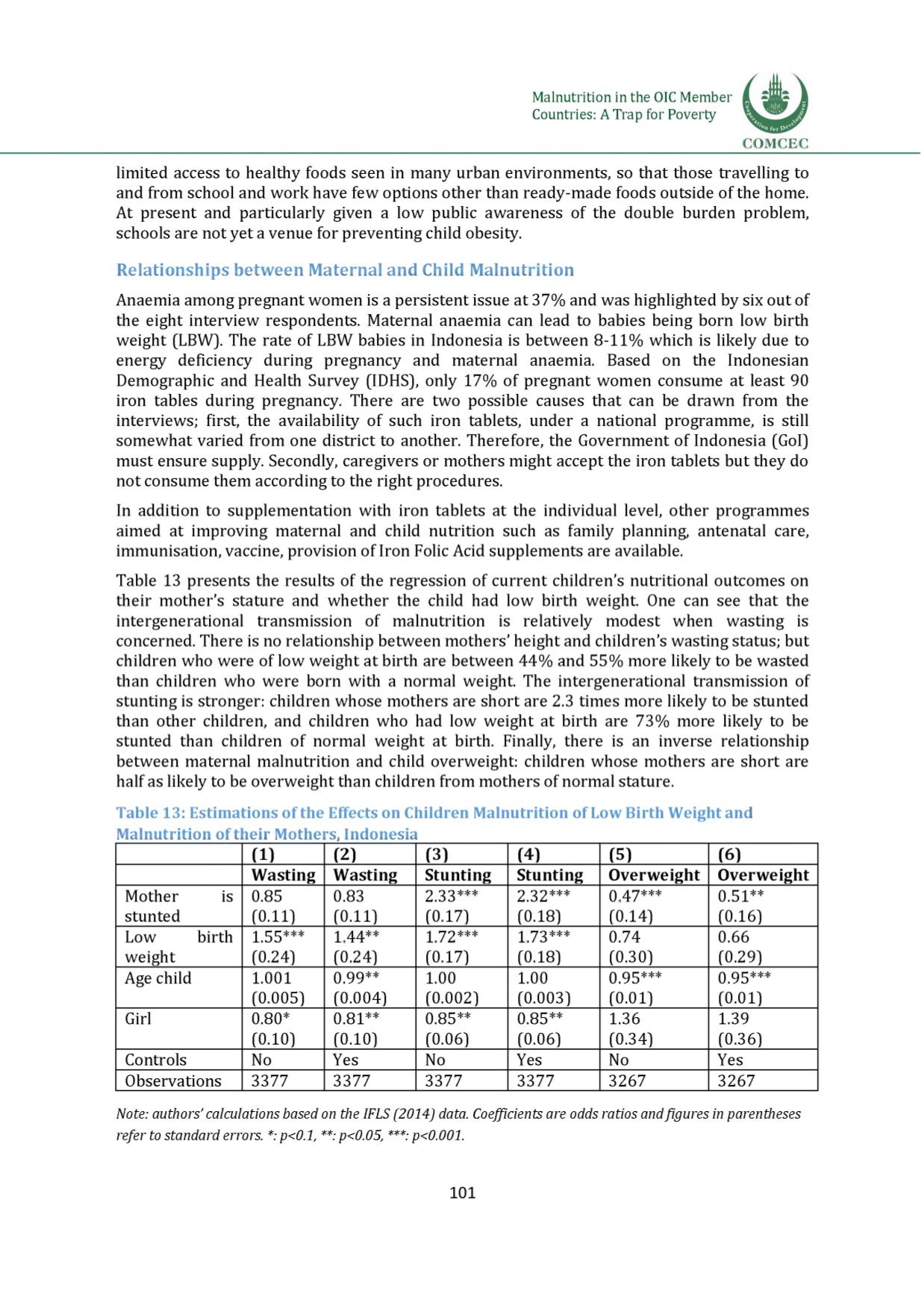

Malnutrition in the OIC Member
Countries: A Trap for Poverty
limited access to healthy foods seen in many urban environments, so that those travelling to
and from school and work have few options other than ready-made foods outside of the home.
At present and particularly given a low public awareness of the double burden problem,
schools are not yet a venue for preventing child obesity.
Relationships between Maternal and Child Malnutrition
Anaemia among pregnant women is a persistent issue at 37% and was highlighted by six out of
the eight interview respondents. Maternal anaemia can lead to babies being born low birth
weight (LBW). The rate of LBW babies in Indonesia is between 8-11% which is likely due to
energy deficiency during pregnancy and maternal anaemia. Based on the Indonesian
Demographic and Health Survey (IDHS), only 17% of pregnant women consume at least 90
iron tables during pregnancy. There are two possible causes that can be drawn from the
interviews; first, the availability of such iron tablets, under a national programme, is still
somewhat varied from one district to another. Therefore, the Government of Indonesia (GoI)
must ensure supply. Secondly, caregivers or mothers might accept the iron tablets but they do
not consume them according to the right procedures.
In addition to supplementation with iron tablets at the individual level, other programmes
aimed at improving maternal and child nutrition such as family planning, antenatal care,
immunisation, vaccine, provision of Iron Folic Acid supplements are available.
Table 13 presents the results of the regression of current children's nutritional outcomes on
their mother's stature and whether the child had low birth weight. One can see that the
intergenerational transmission of malnutrition is relatively modest when wasting is
concerned. There is no relationship between mothers' height and children's wasting status; but
children who were of low weight at birth are between 44% and 55% more likely to be wasted
than children who were born with a normal weight. The intergenerational transmission of
stunting is stronger: children whose mothers are short are 2.3 times more likely to be stunted
than other children, and children who had low weight at birth are 73% more likely to be
stunted than children of normal weight at birth. Finally, there is an inverse relationship
between maternal malnutrition and child overweight: children whose mothers are short are
half as likely to be overweight than children from mothers of normal stature.
Table 13: Estimations of the Effects on Children Malnutrition of LowBirth Weight and
Malnutrition of their Mothers, Indonesia
(
1
)
(
2
)
(3)
(4)
(5)
(
6
)
Wasting Wasting Stunting Stunting Overweight Overweight
Mother
is 0.85
0.83
2.33***
2.32***
0
4 7
***
0.51**
stunted
(
0
.
1 1
)
(
0
.
1 1
)
(0.17)
(0.18)
(0.14)
(0.16)
Low
birth 1.55***
1
4 4
**
1
7 2
***
1
7 3
***
0.74
0 . 6 6
weight
(0.24)
(0.24)
(0.17)
(0.18)
(0.30)
(0.29)
Age child
1 . 0 01
0.99**
1. 00
1. 00
0.95***
0.95***
(0.005)
(0.004)
(
0
.
0 0 2
)
(0.003)
(
0
.
0 1
)
(
0
.
0 1
)
Girl
0.80*
0.81**
0.85**
0.85**
1.36
1.39
(
0
.
1 0
)
(
0
.
1 0
)
(0.06)
(0.06)
(0.34)
(0.36)
Controls
No
Yes
No
Yes
No
Yes
Observations 3377
3377
3377
3377
3267
3267
Note: authors' calculations based on the IFLS (2014) data. Coefficients are odds ratios andfigures in parentheses
refer to standard errors. *: p<0.1, **: p<0.05, ***: p<0.001.
101
















